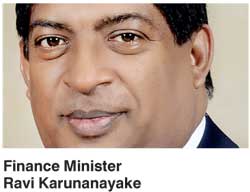Thursday Nov 14, 2024
Thursday Nov 14, 2024
Tuesday, 27 September 2016 00:31 - - {{hitsCtrl.values.hits}}
The Finance Ministry yesterday argued that despite the pending increase of VAT to 15%, the quantum of tax paid by traders would diminish due to the significant number of essential items exempted from VAT and non-payment based on total turnover as currently done.
In a statement the Ministry claimed that traders had to pay 11% VAT on their entire turnover but once the 15% comes into play,  VAT would only have to be calculated on the specific goods that are sold under VAT.
VAT would only have to be calculated on the specific goods that are sold under VAT.
“For instance if a merchant whose daily turnover is Rs. 200,000 and the revenue from the sale of goods liable for VAT is Rs 50,000, he has to pay only Rs. 7500.00, being the 15 % VAT for that Rs. 50,000 under the new amendment. Whereas under the existing system though the VAT payable is 11 %, the same merchant who has the turnover of Rs. 200,000 will have to pay more.
While paying Rs. 5,500 being the 11% VAT for the revenue of Rs. 50,000, he also had to pay an additional 11 % for the revenue of Rs. 200,000 minus the maximum exemption of 25% granted on the total revenue,” the statement argued.
Under the new Act, only the wholesale and retail shops which exceed their daily turnover of Rs. 138, 000 will be categorised as VAT payable merchants. But the uniqueness is that the traders will be charged 15% VAT only on the goods for which VAT is payable, the Ministry said.
“Under the new Act, VAT will not be charged on any essential item. Several health services provided by the private hospital sector have also been exempted from VAT. Among such services are OPD service, Laboratory service and dialysis services.”
The VAT is borne by the final or the ultimate consumer and not by the trader, insisted the statement, pointing out that it is an indirect tax and the Government will receive at the end, through all the intermediary suppliers and wholesale and retailers, an amount equal to the amount paid by the final consumer.
“Under such circumstances, certain factions who had kept tight-lipped when the heavy VAT ranging even up to 20% were charged during the previous Government, have now started to react maliciously. It was observed in the recent past that such groups used the local business community as its cat’s paw by propagating malicious and mischievous remarks on the proposed VAT,” it went on to say.
VAT was introduced to the tax system in Sri Lanka in 2002. At the beginning, VAT was charged under three levels at the rates of 0%, 10% and 20%. In 2005, it was increased as 5%, 15% and 18%. Later, in 2006, VAT was increased to a single rate of 20%.
Former President Mahinda Rajapaksa reduced VAT to 15% in 2007 and then to 12% in 2009. VAT was the tax on domestic consumption of goods and services since its inception but, for the first time, it was extended to retail and wholesale sectors by Rajapaksa in 2013.
Accordingly, supermarkets and other trade outlets engaged in retail and wholesale with a daily turnover above Rs. 2.8 million were brought under the tax net and 12% VAT was imposed on such business institutions. However, this threshold was reduced to Rs. 1.4 million in 2014.
“A limited number of VAT payable goods were included in the turnover but the traders were compelled to pay VAT for the total turnover during that period,” the statement read.